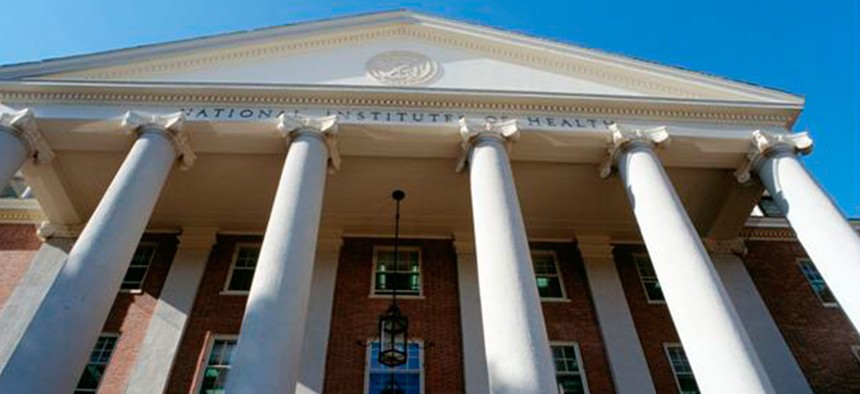
Ernie Branson/NIH
NIH Could Soon See a Significant Funding Boost From Congress
Health-research advocates are pleasantly surprised by the budget numbers coming out of Congress.
For the National Institutes of Health and its supporters, 2015 could turn out to be a pretty good year.
As Congress continues negotiations on a mammoth omnibus spending package, advocates are hopeful that their favored institution is becoming a congressional priority again—and that an extended period of uncertainty may be coming to a close.
It’s a “different atmosphere than we’ve seen in over a decade” said Mary Woolley, the president of the advocacy group Research!America. In the wake of September 11, she said, national defense and fighting terrorism crowded out research funding. “We took our eyes off the ball collectively on focusing on making sure that research for health—and I would say science broadly for that matter—was adequately supported,” Woolley said. She attributes the change this year to “the steady drumbeat of loss of life.”
“People are saying ‘Enough, we have got to find answers and even if it means we’re gonna spend more money than some would like’ ... it’s worth doing,” Woolley said.
Though the exact figures aren’t yet public, the $1.15 trillion spending bill Congress is haggling over could include the biggest bump in NIH funding in 13 years. NIH funding advocates say they’re gratified how members have rallied around the NIH’s cause this year.
The Senate Appropriations Committee signed off on a $2 billion increase for the NIH earlier this year, for a total budget of $32 billion for fiscal year 2016. On the House side, Appropriations legislators called for a $1.1 billion bump, for a total of $31.2 billion. Negotiations for the omnibus could drag into the weekend. House Speaker Paul Ryan said Tuesday morning that his chamber will pass a short-term continuing resolution to fund the government past the December 11 shutdown deadline.
Congress has a long tradition of supporting biomedical research on a bipartisan basis, even if recent years have seen stagnant budgets. “No one is opposed to medical research,” said Patrick White, the president of the advocacy foundation Act for NIH. “The real challenge is what sort of priority do you give it.”
Advocates like White think members of Congress have, quite simply, shifted their priorities. White said the 2013 shutdown over Obamacare was a turning point in the NIH budget question. “I think that’s when people of all persuasions started to realize that not only were there some government functions that were absolutely worth supporting and keeping open,” White said, “but that NIH had first of all been neglected and second of all was something that was worth reinvesting in.” Members of Congress have also been spooked by significant biomedical investments in countries like China, White said, and conservatives in particular are receptive to arguments framing “public-health security [as] national security.”
The NIH has lost roughly 25 percent of its purchasing power since 2003 and just one in six grants sent to the NIH are funded; those are two metrics Director Francis Collins often cites as evidence of his agency’s ill health. Even after the 2013 shutdown, which hit the NIH’s operations hard and generated bad PR for Congress, there wasn’t an immediate funding reversal. In the 2014 budget, the NIH got a $1 billion bump, though that wasn’t significant enough to thrill research advocates. And last year, the NIH’s funds were bumped 0.5 percent, still below the pre-sequestration budget. “There’s no institute here that feels good about their ability to support the science that they’re asked to look at,” Collins said in an interview with Stat News late last month.
Researchers funded through the NIH are rattled not only because, in their view, the agency is funding an insufficient number of grants, but also because the constant budget battles in Congress generate uncertainty. That makes it hard to plan multiyear research projects, and it discourages young scientists from pursuing publicly funded biomedical research.
It wasn’t always like this. From 1998 to 2003, Congress doubled the NIH’s budget to $27 billion as part of a Republican-led, bipartisan push. In the last few years, Newt Gingrich, who was House speaker when the “doubling” began, has called for much more spending on the NIH:
[W]hen it comes to breakthroughs that could cure—not just treat—the most expensive diseases, government is unique. It alone can bring the necessary resources to bear ... And it is ultimately on the hook for the costs of illness. It’s irresponsible and shortsighted, not prudent, to let financing for basic research dwindle.
This year, congressional legislators have come around on some of those very ideas. Ronald DePinho, the president of the University of Texas MD Anderson Cancer Center and a member of Act for the NIH’s advisory committee, began to see signals in early 2015 that Congress was open to giving the NIH a bump. One was the House’s overwhelming support for the 21st Century Cures bill, which would boost funding for the NIH and the Food and Drug Administration, among other provisions. (The Senate is incorporating elements of the House bill into its own legislation, slated for next year.)
In a November 18 letter to the House Appropriations Committee, roughly 100 Republican and Democratic members of Congress called for “at least” $32 billion in funding for NIH in fiscal year 2016. Some Republicans took it a step farther. In a letter to Republican appropriators and House GOP leadership, more than 100 House Republicans called for “a minimum” of $3 billion.
Senate Labor/HHS Subcommittee Chairman Roy Blunt, who backed a $2 billion increase, “will continue to fight for increasing funding on the omnibus,” his spokesman said Monday.
Advocates are careful to note, however, that a year of improved funding won’t change everything—and that this year’s omnibus still needs to get through Congress. Calling the potential 2016 budget a “step in the right direction,” DePinho said it’d take three years of $3 billion increases each year to get the NIH “back to the waterline.”
Researchers on the ground are hoping for a rebound—and fast. When the NIH struggles, biomedical scientists at universities all over the country don’t see even their best grants getting funded. When those grants aren’t funded, researcherspinch pennies in the lab, cut down on staff, or, in some cases, leave science altogether. Heather Duffy, a former assistant professor of medicine at Harvard Medical School, said she never would’ve left the biomedical research field if the grant-funding climate were better. After crafting 18 different grants one year to appeal to peer reviewers, she had the realization that she wasn’t “even doing science anymore,” and left in 2012.
Plus, funding constraints make scientists less bold, DePinho said. Instead of pitching radical ideas in their grant proposals, they craft the safest pitches possible to get the money they need to run their labs. Benjamin Abella, the vice chair of research in the University of Pennsylvania’s emergency medicine department, said he’s seen researchers “retool” their labs to do more work for pharmaceutical companies to pay the bills. That’s work “that may be less innovative, that may be less exciting, and may be less [about] serving the public,” said Abella, who’s been running his own lab for 10 years.
He’s a professor for residents in Penn’s emergency department and has noticed his students’ disinterest in pursuing research as well. “The more they see of my life, they say, ‘We don’t want to do what you do,’” Abella said. “They just have made the calculus that the quality of life and the amount of effort and the amount of stress” isn’t worth it.
NEXT STORY: SEC Pressured to Standardize Financial Reporting







